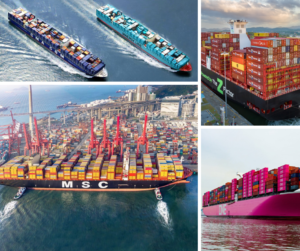Shipping alliances carriers and MSC continue to control over 82% of market

![]()
![]()
As the container shipping industry continues to evolve, strategic cooperation among carriers remains a defining feature shaping global trade. The latest data from Alphaliner show that the dominance of major shipping alliances, together with MSC, the world’s largest independent liner operator, has not only endured but slightly strengthened over the past months.
Even though they do not deploy their entire fleets on alliance services, carriers that are members of the major shipping alliances now control a staggering 82.5% of global container shipping capacity, up slightly from 82.1% four months ago.
Let’s take a closer look at how the container shipping landscape is divided:
MSC (Mediterranean Shipping Company)
Although MSC continues to operate independently, its sheer scale and global reach place it in a league of its own. As of October 2025, the carrier commands 21% of global container shipping capacity, up from 20.6% four months ago.
The growth momentum is further underscored by its orderbook of 127 vessels, which continues to outpace all competitors. MSC’s market influence ensures it remains central to any analysis of global liner dynamics.
Gemini Cooperation (Maersk, Hapag-Lloyd)
Gemini Cooperation partners, Maersk and Hapag-Lloyd, now hold a combined 21.3% share of global container shipping capacity, slightly down from 21.6% in the previous report. Together, they maintain a significant presence across major trade lanes, supported by a joint orderbook of 103 vessels (71 from Maersk and 32 from Hapag-Lloyd).
The partnership continues to focus on streamlining operations and delivering consistent, sustainable services as it prepares to fully implement its network in the coming year.
Ocean Alliance (CMA CGM, COSCO, Evergreen, OOCL)
Long a heavyweight in global trade, the Ocean Alliance members collectively control 28.8% of global container shipping capacity, up slightly from 28.4% four months ago. This makes it the largest alliance in terms of both scale and fleet deployment.
The group’s combined orderbook stands at 244 vessels, including 130 for CMA CGM, 83 for COSCO (together with OOCL), and 44 for Evergreen. This substantial pipeline underscores the alliance’s ongoing commitment to fleet renewal and expansion across key global routes.
The Premier Alliance (ONE, HMM, Yang Ming)
With a combined market share of 11.4%, the The Premier Alliance remains a key force in the trans-Pacific and intra-Asia trades. The group continues to strengthen its position through strategic investments in newbuild tonnage and digital platforms.
Its collective orderbook totals 86 vessels, comprising 51 from ONE, 17 from HMM, and 18 from Yang Ming. While its overall market share has edged down slightly from 11.5% four months ago, the alliance remains well-positioned to compete across high-volume regional and long-haul corridors.
Alliance vs. Non-Alliance Carriers
![]()
The combined capacity of the major alliances, together with MSC, now accounts for 82.5% of global container shipping capacity, up from 82.1% four months ago, leaving 17.5% with non-alliance carriers, down from 17.9% reported in June. The slight shift underscores the continued concentration of capacity among the industry’s largest cooperative groups.
This enduring divide underscores not only the operational advantages and network efficiencies achieved through collaboration but also the increasingly limited room for independent operators to compete across the main East–West trades.
The post Shipping alliances carriers and MSC continue to control over 82% of market appeared first on Container News.
Content Original Link:
" target="_blank">




































































